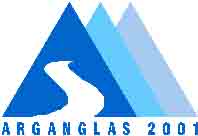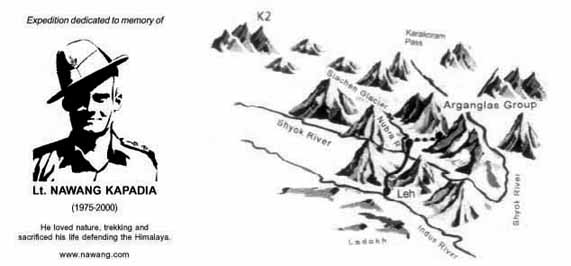
The Arganglas International expedition 2001 Dedicted To Memory of Lt Nawang Kapadia
A team of mountaineers from India (4), U.K.(2) and U.S.A.(2) climbed in the Nubra Valley of Ladakh. The area is situated near the Siachen Glacier in the East Karakoram. The team made the first ascents of three peaks, explored 5 glaciers and attempted two peaks. No mountaineering party had ever visited this area. A large number of peaks are located around these two glaciers which were photographed and recorded.

Leaders of the joint team were Sir Chris Bonington and Harish Kapadia. They had organised two expeditions jointly in the past in the Indian Himalaya. Sir Chris Bonington is the legendary mountaineer from the UK. The other British member was Jim Lowther, the two Americans were Mark Richey and Mark Wilford . Harish Kapadia has vast experience of exploring, climbing and organising expeditions in the Indian Himalaya. The Indian team included Divyesh Muni, Cyrus Shroff and Lt Cdr S. Dam of Indian Navy. Captain Vrijendra Lingwal of Ladakh Scouts joined the expedition a liaison officer.
The Arganglas region near the Siachen glacier is home to the Argans, a community comprising the off-springs of Yarkandi or Kashmiri Muslims who used to frequent the trade routes to Central Asia, (a region that after Sept 11 has leaped back into the international spotlights) and the local Ladakhi women with whom they cohabited.
For armchair adventurers all around the world, sharing the joy of this expedition was just a click away. Pictures from a digital camera were being uploaded and latest information on the expedition was provided on www.bonington.com, thanks to Bonington’s son Rupert who runs a multi-media company in the UK. On a lighter vein members sang praises of the satellite phone. “When the Scotch ran out at base camp we could inform Leh to send some beers.”
The Base camp was set up in a dry lake bed at the foot of the Phunangama Glacier (4800 m / 15,750 ft). Two advanced base camps were set up on the glacier. Teams then divided in smaller teams and operated as small independent parties from there. There is phenomenal potential here for alpine style climbing on peaks up to 6800 meters.
Abale (6360 m / 20,865 ft) and Amale (6312 m / 20,708 ft) and other Peaks : In between companionable bridge sessions, the other members had been occupied with their own climbs and explorations. Shroff and Muni along with Samgyal Sherpa climbed a virgin peak which they named as Abale (6360 m) (“grand father”) with its corniced summit in the Nono glacier just before the heavy snows and clouds came swirling in. Satyabrata Dam, a navy officer from Mumbai and the liaison officer Capt. Lingwal and Sherpa Wangchuk climbed another peak Amale (6312 m) (“grand mother”) The British climbers, Bonington and Jim Lowther were forced back because of bad weather from their attempt but reached an unknown pass Konto La.
First Ascent of peak Yamandaka (6218 m) by its North Face and descent by the Shingskam Topko : The hi-tech could not really minimise some of the risks, or the thrills of the unknown as the two Americans or two Marks — Mark Richey and Mark Wilford discovered. They had a tough but successful climb of the North face of Yamandaka where they had to spend three nights perched on tiny ledges chopped into the ice with just enough room to try and sit or lie down.
From the day they arrived in BC below the Phunangma glacier, Mark Wilford and Mark Richey were at once captivated by the obvious and direct line on peak 6218 m’ s north face. The wall was estimated to be about 4000 ft high and a steep mix of rock and ice. On the 8th of Sept. two Marks crossed the Phunangma glacier and set camp at the base of the face beneath a huge boulder.
From Sept. 9th to the 12th Marks climbed over 20 pitches of 60 meters each of technical rock and ice on the face. All rock climbing was done with crampons in full winter conditions. A fair amount of direct aid was employed including 2 pendulums. They sack-hauled on most of the pitches and the second jumared with a heavy pack. Several sections of frighteningly loose, stacked blocks had to be negotiated. At one point, a television-sized rock, set loose by hand pressure, nearly severed the lead rope. The ice climbing was mainly confined to the initial four pitches of 45 degree snow and ice and then the final three pitches of water ice up to 70 degrees and including the final overhanging cornice. They braved snowfall on all days except the 11th and topped out in a full blizzard which dumped nearly a foot of snow. They made three bivouacs on the face, the first two were excellent platforms and they were able to erect a small tent. The final open bivouac on the face was a narrow ledge chopped into a 50 degree ice slope. Heavy spindrift during the night kept them from much sleep. They also spent one night just below the summit.
The actual summit was reached on September 13th after the storm. Clearing skies allowed superb views of the surrounding mountains and ranges, all unclimbed and unexplored except for the two peaks that the Indians had just summited. Due to the heavy snowfall their original plans of descent down the North East ridge to the Phunangma glacier seemed excessively dangerous. Instead, they opted for a descent down the South face of the mountain to a glacier system on the opposite side of the range.
In fact, the gentle disarming glacier ultimately funneled its way down into a steep and terrifying gorge leading all the way to the Nubra valley. By the time they realized this, they were too exhausted to retrace path, already day 7 on 5 days of food.
Finally, after ten hours of brutal descent, they stood atop a huge water fall longer than their rope. Beyond, the smooth canyon walls disappeared out of sight. Unwilling to make this final commitment, they searched for an escape. One side of the canyon presented a slight weakness. Wilford led up a wall of huge blocks literally cemented in place with mud. As Mark put it “It was the most frightening pitch I have ever climbed” Two more vertical pitches of rock and 500 ft of scrambling led them finally to the Canyon rim and their 7th night out in the Shingskam Topko Valley.
The following morning, they descended to the Nubra valley where they met a very relieved porter sent down to look for us by Harish and Chris. That day expedition companions were ready to send out the search helicopter. Back at ABC, they had built a lovely temple and prayed for their safety.
They named the climb “Barbarossa” after the World War II German/Russian conflict and the book they had been reading in base camp. The peak was later named “Yamandaka” after a Buddhist God, who is fearsome but at the same time benevolent.
Argan Kangri (6789 m) the highest peak on the glacier and was one of the prime aims of the expedition. However bad weather and poor snow conditions did not allow an attempt on this peak till towards the last days of the expedition. The expedition also reached Konto La (5920 m / 19,422 ft) a col between Karpo Kangri (6540 m / 21,460 ft) and Pk. 6640 m at the eastern head of the Phunangma Glacier.
Explorations in the Rassa and Yah Glaciers : Harish Kapadia and S. Dam with three porters formed an independent team and left to explore the above two glaciers in the area. A camp was first made in the Rassa glacier and from here they attempted Thugu Peak (6158 m / 20,203 ft). and then traversed to west to enter the Yah Glacier which is near the shapely peak of Nya Kangri (6480 m / 21,260 ft). The glacier was full of rocky debris and no water was available except near the snout. They camped at the snout and proceeded along the glacier the next day. Covering ground on soft snow and across crevasse they camped at the foot of the pass at the northwestern head of the Yah Glacier. The steep pass, Yah La (5770 m / 18,930 ft), was reached on 23rd September but it was not possible to descend on the other side towards the Sumur Lungpa as intended. The party retraced route back to the Arganglas valley and joined the main team the next day.
On September 11 the maelstrom that shook the world seemed to have set off cataclysms in nature too. Fierce storms erupted and the snow never really melted away. It was time to go home and the expedition was called-off a week earlier than planned.
With memories of what both Sir Chris Bonington and Harish Kapadia asserted were of a very happy, well-knit team, proving that international expeditions need not necessarily mean endless squabbles, flag-waving and chest-thumping displays. Cyrus Shroff in his unassuming manner summed up the experience, “We jelled together from the day the international team landed in Mumbai. We were partying from that day till the day we said our farewells. And yes, in between we did get to climb a few mountains.” If there were regrets it was because as Jim Lowther said, “We were here for enjoyment, for pleasure, for a challenge, but this very playground for us is also a battle arena (the Siachen) where men are fighting, sacrificing their lives.”
A full report on the expedition will be available at www.harishkapadia.com


